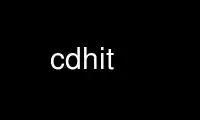
This is the command cdhit that can be run in the OnWorks free hosting provider using one of our multiple free online workstations such as Ubuntu Online, Fedora Online, Windows online emulator or MAC OS online emulator
PROGRAM:
NAME
cdhit - quickly group sequences
SYNOPSIS
cdhit [Options]
DESCRIPTION
====== CD-HIT version 4.6 (built on Jan 23 2016) ======
Options
-i input filename in fasta format, required
-o output filename, required
-c sequence identity threshold, default 0.9 this is the default cd-hit's "global
sequence identity" calculated as: number of identical amino acids in alignment
divided by the full length of the shorter sequence
-G use global sequence identity, default 1 if set to 0, then use local sequence
identity, calculated as : number of identical amino acids in alignment divided by
the length of the alignment NOTE!!! don't use -G 0 unless you use alignment
coverage controls see options -aL, -AL, -aS, -AS
-b band_width of alignment, default 20
-M memory limit (in MB) for the program, default 800; 0 for unlimitted;
-T number of threads, default 1; with 0, all CPUs will be used
-n word_length, default 5, see user's guide for choosing it
-l length of throw_away_sequences, default 10
-t tolerance for redundance, default 2
-d length of description in .clstr file, default 20 if set to 0, it takes the fasta
defline and stops at first space
-s length difference cutoff, default 0.0 if set to 0.9, the shorter sequences need to
be at least 90% length of the representative of the cluster
-S length difference cutoff in amino acid, default 999999 if set to 60, the length
difference between the shorter sequences and the representative of the cluster can
not be bigger than 60
-aL alignment coverage for the longer sequence, default 0.0 if set to 0.9, the
alignment must covers 90% of the sequence
-AL alignment coverage control for the longer sequence, default 99999999 if set to 60,
and the length of the sequence is 400, then the alignment must be >= 340 (400-60)
residues
-aS alignment coverage for the shorter sequence, default 0.0 if set to 0.9, the
alignment must covers 90% of the sequence
-AS alignment coverage control for the shorter sequence, default 99999999 if set to 60,
and the length of the sequence is 400, then the alignment must be >= 340 (400-60)
residues
-A minimal alignment coverage control for the both sequences, default 0 alignment must
cover >= this value for both sequences
-uL maximum unmatched percentage for the longer sequence, default 1.0 if set to 0.1,
the unmatched region (excluding leading and tailing gaps) must not be more than 10%
of the sequence
-uS maximum unmatched percentage for the shorter sequence, default 1.0 if set to 0.1,
the unmatched region (excluding leading and tailing gaps) must not be more than 10%
of the sequence
-U maximum unmatched length, default 99999999 if set to 10, the unmatched region
(excluding leading and tailing gaps) must not be more than 10 bases
-B 1 or 0, default 0, by default, sequences are stored in RAM if set to 1, sequence
are stored on hard drive it is recommended to use -B 1 for huge databases
-p 1 or 0, default 0 if set to 1, print alignment overlap in .clstr file
-g 1 or 0, default 0 by cd-hit's default algorithm, a sequence is clustered to the
first cluster that meet the threshold (fast cluster). If set to 1, the program will
cluster it into the most similar cluster that meet the threshold (accurate but slow
mode) but either 1 or 0 won't change the representatives of final clusters
-bak write backup cluster file (1 or 0, default 0)
-h print this help
Questions, bugs, contact Limin Fu at [email protected], or Weizhong Li at [email protected]
For updated versions and information, please visit: http://cd-hit.org
cd-hit web server is also available from http://cd-hit.org
If you find cd-hit useful, please kindly cite:
"Clustering of highly homologous sequences to reduce thesize of large protein
database", Weizhong Li, Lukasz Jaroszewski & Adam Godzik. Bioinformatics, (2001)
17:282-283 "Tolerating some redundancy significantly speeds up clustering of large
protein databases", Weizhong Li, Lukasz Jaroszewski & Adam Godzik. Bioinformatics,
(2002) 18:77-82
Use cdhit online using onworks.net services
